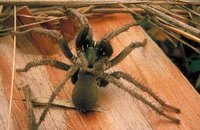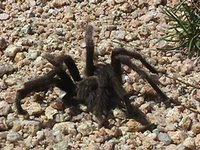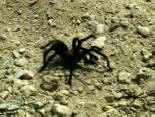| Tarantula, Tarantulas are the largest spiders in the world - some in Central America are as big as a dinner plate! There are about 30 species in Arizona, ranging in size from 2 - 3 1/2". |
Source: National Park Service Tonto National Monument
Tarantula Web, A tarantula spins silk, but not in the form of a web for catching food. Instead, the silk is used to line the burrow, and by the female to line the nest and cover the eggs.
Self Defense, If provoked, the tarantula may inflict a painful bite, about like a bee sting. (The tarantula hawk's sting is much more painful.) However, the tarantula has a rather gentle nature, and rarely uses its fangs except to catch prey. When alarmed, it may raise its front legs and its abdomen to look aggressive. It may also release stinging hairs from its abdomen. These hairs irritate the skin of an attacker by digging themselves in with hundreds of tiny hooks.
 | This spider is about half the size of the more commonly seen tarantula. It lacks stinging hairs, and it is quite aggressive. National Park Service Pinnacles National Monument |
 | Spiders, too, live in this area. Tarantulas, although not very appealing to look at, are fascinating to study. These spiders are usually reluctant to attack people, but when they do, their venom is no more poisonous than a bee sting. National Park Service Tumacácori National Historical Park |
 | This image is in the public domain and may be reproduced, free of charge with the proper credit line, National Park Service Yellowstone Digital Slides: Spiders, Tarantula by R.Robinson |
 | Common Name: Tarantula, Latin Name: Aphonopelma chalcodes, Habitat: Desert Soil, Range: Arizona, New Mexico and Southern CaliforniaNational Park Service Mojave National Preserve |
Ownership, Information presented on these websites, unless otherwise indicated , is considered in the public domain. It may may be distributed or copied as is permitted by the law.
 | Although rarely seen, the Tarantula, Spider is right at home at Fish Springs US Fish and Wildlife Service Fish Springs National Wildlife Refuge |
 | Male desert tarantulas (Aphonopelma chalcodes) are most visible at dawn or dusk, particularly in the late fall and spring when temperatures are most suitable for them to travel in pursuit of females. |
Information presented on this website is considered public information and may be distributed or copied. Use of appropriate byline/photo/image credit is requested. (Death Valley National Park, U.S. Geological Survey, Department of the Interior)Source: USGS Death Valley
Generally speaking, works created by U.S. Government employees are not eligible for copyright protection in the United States. See Circular 1 "COPYRIGHT BASICS" from the U.S. Copyright Office.
Anyone incorporating a work of the U.S. Government into a copyrighted work should be aware of 17 U.S.C. § 403. This section requires a copyright notice to contain a statement identifying what portions of the work consist of a work of the U.S.Government.
Leave a comment, make a request, Let this small sampling be a guide to better quality, more plentiful, public domain, royalty free, copyright free, high resolution, images, stock photos, jpeg, jpg, free for commercial use, clip art, clipart, clip-art. more at Public Domain Clip Art and clip art or public domain and US Fish and Wildlife Service or Spiders and Department of the Interior or Tarantula and USGS or National Park Servuce and Arachnids













No comments:
Post a Comment